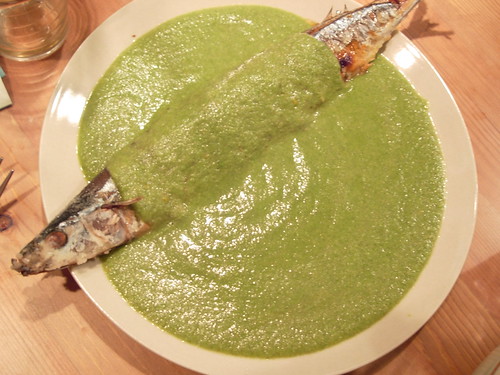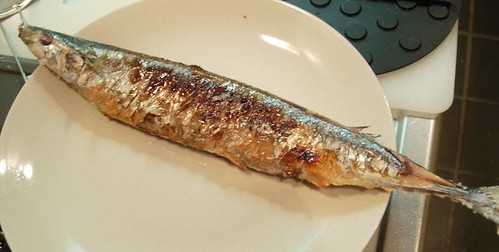I had decided to make Mexican food tonight, using some nice recipes from Diana Kennedy. Before I get to what I made, and how, and like that, let me continue my musings on odd absences and gaps in Japanese food availability.
Why No Mexican?
As I discussed recently, I find it mind-boggling that you cannot get basic Chinese ingredients without an extensive search; we ultimately did find things like fermented black soybeans at a Chinese specialty shop, but I still wonder why you can’t get them in an ordinary store. With Mexican foods, I understand that there is no established connection the way there is with China, but I nevertheless find it strange that this cuisine has so little presence here.
If you think about real Mexican food, not Tex-Mex, you note that it’s dominated by a number of basic ingredients: citrus, fresh herbs, tropical fruits and vegetables, rice, corn, pork, mild dairy products, and an enormous amount of seafood. According to Kennedy and other experts, Mexicans who are into food tend to be quite bonkers about seafood: fresh, local, and all that. Some Mexican foods are of course very spicy, because of the use of chiles in various forms and of many kinds, but this isn’t true of all Mexican food by a long chalk. In fact, it’s quite common to use some of the more intensely-flavored chiles only for flavor, not heat: in many Yucatán dishes, for example, you take habanero chiles, whole and uncut, and let them sit in a hot sauce for a little while, just to infuse the flavor but not to make the dish spicy at all.
Now the only thing I can see many Japanese people objecting to about this cuisine is the spicy thing. Not that there aren’t Japanese spice-maniacs, but certainly the majority of the food here is very mild on that score. Otherwise, this strikes me as exactly the sort of thing Japanese people would love: lots of fresh seafood and tropical vegetables, rice, mild cheese and cream, a little pork or chicken here and there.
But it’s not here. There are Mexican restaurants, but not many, and from the various reviews and descriptions I have read, they tend to be pretty mediocre. As far as I have found, there are something like five or six Mexican restaurants in Kyoto, grand total — and this is a city where restaurants pretty much dominate all other kinds of shops.
So if you’re reading this and you’re a serious Mexican chef, let me suggest that you could get in ahead of the wave. You focus on fresh seafood, you put occasional markers on your menu when something is spicy, and you avoid the things that have become American Tex-Mex commonplaces. Somebody is going to do this, and it’s going to be the next hot thing, the way Italian was quite recently. Go ahead: I bet you could do very well. If you make a fortune, cut me off a piece of it, okay?
Mexican At Home
Based on what’s available and fresh — and what my son will eat — I decided to do two dishes and some little sides. I’d do a chicken-rice-vegetable one-pot thing, a great deal like what the Japanese call a zosui but with very different herbs and spices. I’d do a broiled sanma (Pacific saury) briefly simmered in a green, somewhat spicy sauce. And then I’d do some basic salsa, guacamole, and the like to use as salad/garnish.
The most interesting dish, and in some ways the most successful, was the fish.

Kennedy’s recipe calls for a mild, firm-fleshed white fish, like a sea bass. She has you poach it until barely done, use the stock to make a sauce, and then cook the fish in the sauce to re-warm and marry the flavors. I thought the fish would probably be overdone this way, and I don’t really like poached fish. So I decided to try a merger of Mexico and Japan.
First I made stock: I took the head and frame of a red snapper I had in the freezer from earlier this week, added some frozen vegetable trimmings from my box that I keep for the purpose (carrots, bits of tomato, onion, scallion, etc.), then added a bay leaf, a generous sprinkle of oregano, and half a yuzu, which is a very sour but floral local citrus fruit. I covered it with water, brought to a very gentle simmer, and left it there for an hour or so. Then I strained coarse, then fine, and had good fish stock. (Red snapper, or sea bream, Japanese tai, makes fabulous stock.)
Then I got a sanma (Pacific saury). I got it at Daimaru, rather than my local grocery store, because I was there and besides I wanted something really good. It had already been lightly salted, so I just rinsed it off.
To make the sauce, I put a bunch of stuff in my immersion blender jar and processed until smooth. (See recipe below.) About 15 minutes before dinner, I sauteed garlic, added the sauce and simmered rapidly over medium heat. Then I cooked the fish.
To do this, I used the Japanese shio yaki style. I rubbed the fins with salt, then put the fish under the broiler until very brown and crispy on one side, flipped the fish with chopsticks, and broiled the other side. I now put the fish onto a plate, remove the whole garlic cloves from the sauce, and poured the sauce over. You can see the results: visually pretty cool, I thought.
The flavor was excellent. I think the shift from a mild fish to a dark-fleshed one required more chile and perhaps more cilantro — certainly it needed a bit more salt in the sauce to stand up to the salty fish. Other than that, it was very good. I did think the sanma liver (you grill these things whole, ungutted) was rather bitter, but I am informed that this is usually the case and not my fault.
I’d do it again, no question. But I think I’d use (a) a milder white-fleshed fish, like a small red snapper, (b) more cilantro and salt, and (c) at least double the amount of chile. Then I could serve it with plain rice and something mild for salad and have a pretty wow dinner.
I do think that if I didn’t do the extra chile, the resulting dish would be very much to the taste — visual as well as palatal — of a lot of Japanese people. The sauce is exciting and complex, but it doesn’t overwhelm the fish at all, which would be the big objection. I think it could have been garnished with a little minced tomato, in a line down the fish, for prettiness’ sake, but the intense green and the crispy whole fish made a great combo.
One thing I do need, as you see, is better dishes: this should not have been put on a blah round white plate. Oh well — I am, after all, in Japan, where beautiful handmade dishes are surprisingly inexpensive. So maybe soon I’ll start upgrading my presentations.
The Recipe
[To serve 2 as a main course with salad and rice]
Ingredients
1 pound fish frames for stock
2 cups stock vegetables: carrot, turnip, onion, tomato, celery, etc. trimmings
1 tsp dried oregano (or 3 sprigs fresh)
1 bay leaf
1 large wedge sour citrus, preferably lime or similar
2 smallish whole fish (Spanish mackerel, trout or bass, whatever looks good)
1 cup coarse salt, e.g. kosher
1/4 cup blanched, peeled almonds
1-2 whole hot chiles, e.g. serranos
2 Tb capers, drained
1/3 cup unflavored bread crumbs
4 lettuce leaves, torn coarsely
1/4 cup onion, chopped
10-15 sprigs cilantro, coarsely chopped
4 cloves garlic, peeled
1 Tb cooking oil
salt and pepper to taste
Method
Put the frames, vegetables, oregano, bay, and citrus in a small saucepan and cover with cold water. Bring slowly to a simmer, and simmer gently for 1-2 hours, skimming any scum that rises. Strain coarsely, then very fine, and reserve. You should have about 2 cups.
Rinse the fish and scale if necessary. Rub all surfaces lightly but thoroughly with coarse salt and let the fish sit on a countertop for about 30 minutes.
Put the almonds in a blender and process until as smooth as you can get them. Add 1 cup of the reserved stock and process again, scraping as necessary, until very smooth. Add all the remaining ingredients except for 2 cloves garlic and puree until very smooth. If it seems very thick, add 1/4 cup more stock and puree. Salt generously to taste.
Rinse the fish all over and dry well with paper towels. Rub all the fins, the head, and the gill flaps generously with coarse salt.
Put the oil in a wide saute pan and heat. Add the 2 reserved garlic cloves and saute until just golden. Add all the sauce, plus another half-cup stock, and stir gently. Let simmer 15 minutes; if it gets too thick, add more stock.
While the sauce simmers, turn the broiler on full-blast. Set the rack to be about 5 inches from the flame, and oil the rack very well. Put about 1 cup water in the bottom of the broiler pan, which will help with the cleanup immensely. Put the rack under the flame for a couple of minutes before adding the fish.
Put the fish on the rack, lying on their right sides (if the head is to the left, the belly should be toward you). Broil 3-4 minutes, until the skin is very brown and crisp, and bubbling up in places. (Adjust the rack distance to get this effect in this time.) With chopsticks and/or rubber or wooden spatulas, gently turn the fish over — tongs don’t work. Broil another 3-4 minutes on the other side, until brown as before.

Turn the fish again and remove, with a wide spatula or two, to serving plates. The sauce should be ready: remove the whole garlic cloves and pour over the fish. Serve at once with plain rice and a simple, fresh salad. Chips and fresh tomato salsa are an excellent side with this.
Total cooking time: 3 hours, including stock-making, which can be done a day in advance
Total active cooking time: 30 minutes




No comments:
Post a Comment